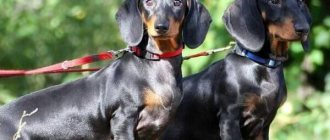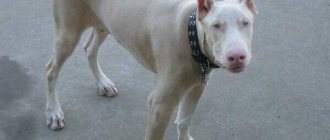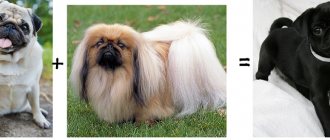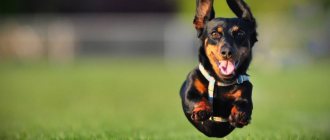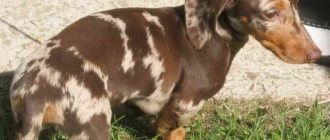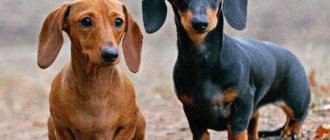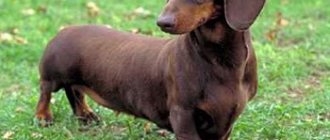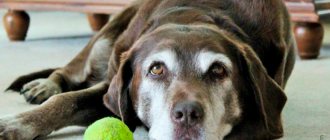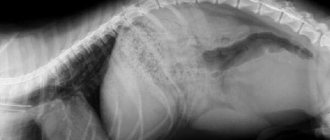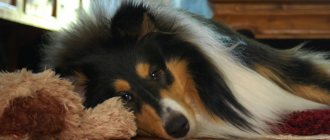History of the Dachshund breed
Dachshund
The Dachshund is a hunting dog intended for burrow hunting, and in this segment it can rightfully be considered the oldest breed. Although dogs similar in appearance to dachshunds are found even in ancient Egyptian images, it is generally accepted that the modern phenotype began to take shape in the 16th century. The birthplace of the breed is the German state of South Saxony.
The main ancestors are German short-legged Bracket hounds. Having retained all the best hunting qualities of the latter, the dachshund was able to turn their disadvantage - short limbs - into a big advantage, and became an indispensable dog for burrow hunting.
German burghers, suffering from badger raids on agricultural land, quickly appreciated all the benefits of the dachshund. The breed did not lose its position even during the active development of cities in Germany, because keeping a dog was convenient and not expensive.
Very energetic, intelligent and loyal, the dachshund by the end of the 17th century was increasingly winning the hearts of the Germans. Active breeding of representatives of this breed has begun. The number of dachshunds increased very quickly, the first nurseries appeared in Germany, and soon the breed began to spread throughout Europe. There was no uniform approach to breeding principles at that time. Each breeder solved the problem based on his personal ideas and preferences. As a result, two main directions in breeding gradually emerged - working and decorative.
The logical conclusion of the breeding work was the adoption of the first breed standard in 1870. The main purpose of breeding dachshunds was hunting. Ten years later, von Bosch developed an artificial den for training and training dachshunds, and since 1893 this structure has been used for working tests of dogs. The modern FCI classification places dachshunds in a separate group with the greatest variability - 9 varieties of the breed are officially recognized and standardized.
Dachshund puppy
In Russia, the dachshund has been known since the mid-18th century, although the breed did not initially become widespread. In 1900, the Russian Society of Fox Terrier and Dachshund Lovers appeared, and from that time on, specialized exhibitions began to take place, and stud books appeared.
The dachshund became increasingly popular, although the residents of our country perceived it more as a decorative dog. Among the famous owners of dachshunds one can name the great Russian actress Maria Ermolova, the writer A.P. Chekhov, who very much loved his four-legged pets - Brom Isaich and Hina Markovna. Among foreign celebrities, one can recall a big fan of dachshunds, oceanographer Jacques Yves Cousteau.
The bloody 20th century with its two world wars had an extremely negative impact on the number of representatives of the breed in Russia. Only 11 dogs were presented at the exhibition in 1958.
Fortunately, the situation was corrected. Today, the dachshund is one of the most numerous and popular breeds in our country.
What do the puppies look like?
The weight of a dachshund puppy at 2 months is reduced to 2-3 kg, at 3 months it is already exactly 3 kg. If at the age of two months the puppy weighs less or more than 3-4 kg, then according to the standard this is recognized as a defect.
However, the appearance of the pet is formed over the course of 16-24 months, and according to dog handlers, changes in the animal’s coat take even longer – up to 4 years. For the first few weeks, puppies are covered with fluff, so it is difficult to guess the color and type of coat. This will be possible only by 5-8 months, when the puppy begins to grow fur.
Appearance of a dachshund
Running dachshund
The main distinguishing feature of dogs of this breed is a long body on short limbs. There is a division into varieties depending on the size and type of coat.
By size:
- standard fees. Male weight – 7-9 kg, female – at least 6.5 kg;
- small dachshunds. Male weight – up to 7 kg, female – up to 6.5 kg;
- rabbit dachshunds. Weight up to 4 and 3.5 kg, respectively.
The chest circumference of rabbits is up to 30 cm, small - 30-35 cm, standard - more than 35 cm.
Height at withers – from 12 to 27 cm depending on the variety.
Head
Elegant, quite dry, wedge-shaped. The skull is flat on top. The muzzle is slightly hook-nosed and long. The transition to it is not abrupt, rather smooth and smooth. The lips have a slight fold at the corners. The nose is large, brown or black, depending on the color of the animal.
Rabbit dachshund
Small dachshund
Standard fee
Teeth
The dachshund's teeth are large, powerful, in a complete set of 42 pieces. Scissor bite. The jaws are strong.
Ears
Dachshund ears are medium length, hanging, rounded. Located close to the back of the head, high. The leading edge should touch the cheek.
Eyes
Oval, medium size. Set wide apart. Color - from reddish brown to dark brown. White, blue eyes are allowed (though still undesirable) in marbled dachshunds.
Neck
Muscular, tall, quite long. The scruff is slightly convex.
Dachshund face
Frame
The back line is straight or slightly sloping towards the croup. The loin is long, with well-developed muscles. The chest is wide, with the chest bone pushed forward. The ribs are rounded, reaching down to the middle of the forearm. The withers are well defined. The abdomen is moderately tucked.
Limbs
Dachshund paws
The front ones are straight when viewed from the side. The forearms are short and located almost vertically. Elbows point straight back. The limbs are very muscular with strong bones. The feet are well-knit, arched, with well-developed pads and strong, strong nails.
The dachshund's hind limbs are proportional in length to the front, muscular, with strong bones. Placed in parallel. The angles of the stifle and hock joints are well defined. Paws are balled, standing firmly on well-developed healthy pads.
Tail
The tail of dachshunds is not set very high. Carried along the topline, moderate saber-shape is possible.
Wool
There are three varieties.
Rabbit dachshund
- Smooth-haired dachshund. The coat is short, thick, shiny, without the slightest sign of bald patches. Adheres well to the skin. It feels hard and dense to the touch. Hair length – up to 2 cm.
- Wire-haired dachshund. Thick coat with undercoat, straight, close-lying on all parts of the body with the exception of the ears, eyebrows and muzzle. The face has a well-defined beard and bushy eyebrows. The fur on the ears is almost smooth and noticeably shorter than on the body. It feels hard to the touch. The average hair length is about 3 cm.
- Long-haired dachshund. Smooth, shiny coat with undercoat, lying well on the body. Forms a fringe on the ears. The feathering on the back of the legs is well defined. Reaches its greatest length on the underside of the tail.
Wirehaired Dachshunds
Longhaired dachshunds
Color
Yellow-red and pure red of various shades, black, gray or brown with rusty-red or clear yellow markings, marble of the listed colors. Wirehairs are characterized by a “boar” color from light to dark shades.
Any deviation from the above points is considered a defect or a disqualifying characteristic depending on the degree of severity.
A detailed list of defects, vices and disqualifying characteristics is given in the description of the FCI breed standard, group 4, Dachshunds.
Photo of an adult dachshund
Dachshund character
Dachshund with his beloved owner
“With self-esteem, with a strong character and therefore arousing such sympathy,” says the inscription on the emblem of the German Tekel Club. This phrase can easily be considered one of the most accurate and succinct characteristics of this animal.
Fearlessness, pronounced individuality, amazing ingenuity and independence in decision-making, which indicates high mental abilities - all this is a dachshund.
Some owners note a certain stubbornness and disobedience in the behavior of their pets. We can agree with this, but we should not forget that the dachshund is a hunter, and of burrowing animals. And not only the success of the hunt, but also her life depends on her ability to make the right decision without commands and prompts from her owner during a fight with a badger or fox in a narrow hole. And the dachshund is stubborn not out of spite - she simply understands this situation better than you (in her opinion). If your opinions coincide, the command will be carried out accurately and without delay, which is why it is so important to establish close contact and mutual understanding with your pet. With a good, loving owner, a dachshund is always responsive and obedient.
Adorable dachshund puppy
Despite their small size and original appearance, dogs of this breed are distinguished by self-confidence and, in modern terms, the absence of complexes. Nature left no place for servility in the heart of this dog. A dachshund will never forgive a rude disrespectful attitude towards itself, the reaction will be adequate. Disobedience, sabotage, doing things out of spite - the dog uses all available means to assert its “I”. The basis for building good relationships can only be mutual respect.
The dachshund has proven itself to be an excellent companion. She can act level-headed and even somewhat philosophical, but in the right atmosphere she becomes a cheerful, inventive minx. These dogs get along well with children, happily taking part in a variety of fun activities. In addition, representatives of the breed are very clean.
Many people are struck by the discrepancy between the size of the dachshund and its voice. A powerful and loud bark can deceive not only a fox hiding in a hole, but also an uninvited guest who comes to the door of your house.
This dog loves walks and will gladly accompany you even on the most distant hikes.
Dachshunds are great connoisseurs of comfort. In the house, they choose the warmest and most comfortable corners for themselves; they like to relax, crawling under the blanket or on the lap (or even on the neck) of the owner. They gladly accept affection from members of their household.
The character of the dachshund is an amazing combination of integrity, strength, tenderness and love for people.
Walking with a dachshund
Character traits
The character of the long-haired dachshund does not differ much from other representatives of the breed. Along with other relatives, this species is not devoid of hunting traits and is ready to play the role of a guard along with other dogs.
Well oriented in space. This can be understood by the speed with which the dog takes up all the warm and cozy places in the house.
She is also not devoid of a sense of ownership. Therefore, if the owner, without good reason, reaches out to the object the dachshund has chosen, be prepared for a warning growl. A sense of ownership also manifests itself in relation to territory. Most dachshunds show genuine wariness when welcoming new guests into the house.
Expert opinion
Kozhevin Semyon Kirillovich
Expert dog handler.
The first thing that strikes you is character. While other dachshund cousins are stubborn, the long-haired dachshund is characterized by a delicate approach. But, despite its gentleness, the dachshund remains true to its nature and can compromise its principles if circumstances contribute to this. For example, danger. After all, the dachshund is a territorial animal.
Education and training
Ready to serve!
The Dachshund is an intelligent and quick-witted dog. She will quickly understand that permissiveness and connivance on the part of the owner is very healthy, so you need to start raising your pet from the very first day you meet.
Training can wait a little, but you need to teach the dog its name, diet, place, and explain to the baby “what is good and what is bad” right away. Success in education can be achieved only on the basis of establishing close contact and mutual understanding with the animal.
It is not difficult to accustom a puppy to a nickname. Calling him by name, caress him, treat him with something tasty. Don't forget to reward if the animal, responding to its name, runs up to you. Little dachshunds are very cute, and you will have to show a certain strength of character when accustoming them to a place, because you really want to take this miracle into your bed or let him lie on a chair. It will be almost impossible to wean a dachshund from such behavior, so it is better to immediately stop such attempts by gently and carefully each time carrying the dog to its rug, while repeating the command “Place!” Don't be afraid to clearly express your displeasure with your puppy's misbehavior. The main thing is that your “Ugh!” sounded to the point.
Dachshunds are very clean, so it’s not difficult to teach your baby to relieve himself in the litter box. You just need to take the puppy to the toilet on time (after sleep, after eating, or if the dog starts to behave restlessly). It is clear that it must stand in a specific place. When walking outside begins, the tray can be removed. At the same time, attempts - especially successful ones - to go to the toilet in the apartment are assessed negatively (in no case punishing), and the same actions on the street are encouraged in every possible way.
It is very important in raising a small dachshund to adhere to a regimen of feeding, games, and walks.
Why are we sitting?
Dachshunds are smart dogs and are easy to train. Training takes place according to the principle “from simple to complex”. Achieve the execution of the basic commands “Sit!”, “Near!” or “Lie down!” It will be easier if you can interest your pet. The choice of method largely depends on the temperament and character of the puppy. Considering that dachshunds are real gourmets, training that uses a favorite treat as a reward gives good results.
The dachshund is a dog that, by its nature, actively reacts to external stimuli, so it is important to move your activities outside from the age of three months so that the baby gets used to extraneous noises and learns to respond only to your commands.
The training process should not contain any elements of violence. If the dog is tired and ignores you, reschedule the training.
Training a dachshund is a fun activity, and how far you want to go with the process is up to you. In principle, you can teach your pet almost all the skills that a dog’s mind can handle.
Pets!
Shall we play ball?
Care and maintenance
The Dachshund is perfect for keeping at home, and caring for it will not require any excessive effort from you.
Before you bring a puppy into your home, you need to do some preparatory work, namely:
Dachshunds at a dog show
- carefully inspect the apartment and put all household chemicals and indoor plants out of reach of the dog, pack loose electrical cords in special boxes;
- wash the floor and hide all shoes;
- prepare places for feeding and resting the dog, buy all the necessary accessories;
- stock up on moisture-absorbing diapers and purchase a special tray (with or without a post). A dachshund (especially a small one) has very active metabolic processes, and these items will definitely come in handy.
You will also need a nail clipper, a leash up to 5 meters long, and means for bathing and caring for the animal’s eyes and ears.
The dachshund rug should be placed in a warm, cozy place, away from drafts and heating appliances. A soft flannelette blanket covered with a sheet that can be washed when dirty is best.
Basic rules for caring for a dachshund.
- For bathing, use specially designed shampoos. The frequency of water procedures is once every three to four months, no more often. It is not recommended to bathe small (under six months old) puppies. Washing dirty paws after a walk doesn't count.
- Be sure to trim your baby's nails once every two weeks. An adult dachshund wears them off herself during walks, and she may need such manipulation about once a quarter.
- Inspect your eyes and wipe with a clean cloth soaked in warm water, removing accumulated secretions.
- When the ears become dirty, clean them with a cotton swab dipped in a weak solution of hydrogen peroxide.
- Smooth-haired representatives of the breed can be dried with a terry towel or mitten. Long-haired dachshunds need to be systematically brushed with a special brush.
- Clean your dog's teeth regularly. This is the best prevention against the appearance of tartar and possible gum inflammation.
Longhaired dachshund
Important! The owners of these cute dogs should know that:
- Dachshunds should not be allowed to jump down even from a small height;
- It is forbidden to pick up puppies by the scruff of the neck. When lifting your baby, hold him under the chest with one hand and support his hind legs with the other. To avoid injury to the elbows, do not lift the puppy under your paws;
- Small children should not be allowed to carry a puppy in their arms - they simply may not be able to hold it;
- It is better to choose dogs of suitable size for your dachshund as playmates;
- Do not take the puppy outside until all necessary vaccinations have been received.
It is very important not to overfeed the animal. Excess weight is the enemy of the dachshund, as it creates unnecessary stress on the spine.
It is not advisable to use dry food for a puppy. This dog is not so large that it cannot be given a balanced diet of natural products.
Dachshund got a treat
The dachshund menu must include the following products: low-fat cottage cheese, cereals (rolled oats, rice, buckwheat), which can be cooked in meat broth or pieces of meat (beef, lamb, chicken or turkey) can be added to the dish, although dairy products would be preferable for puppies porridge. Vegetables are also useful in the diet; twice a week you can give your dachshunds eggs, mixing and grinding them with cottage cheese. It is quite acceptable to give fish (sea and boneless) once or twice a week. But milk in its natural form will not bring any benefit to the dog - it simply is not absorbed by the animal’s body.
Don't forget about mineral supplements, especially powdered clay, which is very useful for dachshunds.
Food from our table, sweets, spicy and spicy dishes do not need to be offered to the dog.
Dry formulas are better suited for an adult dog. Premium food in this case is a completely acceptable alternative to a natural diet.
Basic rules of care
The dog's coat is soft and not devoid of the ability to wear out, so hair care requires consistent brushing at least several times a week, followed by combing out the undercoat. A bristle brush and a wide-tooth comb help with this.
The eyes are regularly checked for accumulated dirt and secretions, which are promptly removed with a dampened cloth.
Dirt and wax are also removed from the ears, but using a cotton swab so as not to damage the ear canals.
In dental care, it is recommended to buy special pastes and gels, which, at the same time as cleaning, provide prevention against various diseases.
Nails are trimmed every 2 weeks or as they grow. Make sure that there is no damage to the claw tissue.
IMPORTANT!
Most owners are inclined to buy overalls, but this type of clothing has a bad effect on both the pet’s hair and gait. Not recommended for show dogs.
Dachshund health and illness
Aristocrat dachshund
Dog diseases, characteristic of most breeds, can manifest themselves to varying degrees in dachshunds, and the methods of treating them are quite traditional and typical. However, there is one “but” that should please the future owner - these pets, in principle, very rarely get sick. And this is an indisputable fact.
There are two diseases that are found only in representatives of this breed. The first is a disease called the “swimmer’s effect.” It occurs in early puppyhood and outwardly manifests itself in the fact that one-month-old puppies cannot rise to their paws and move by crawling, making “swimming movements” with their paws. In most cases, this is a transient condition that does not in any way affect the health of grown-up dachshunds - they stand up on their limbs and walk perfectly. However, the negative development of the disease, although rare, still occurs. As preventive measures, it can be recommended not to overfeed babies and make sure that they are not on slippery surfaces, where it is difficult for their still weak legs to find support.
The second disease, classified as hereditary, poses an incomparably greater threat to the dog’s life. We are talking about intervertebral disc dysplasia. The fairly high incidence of this disease is associated with the characteristic body structure of the dachshund. Problems with the intervertebral discs can lead to pinching of the spinal cord body, deformation of the nerve trunks and, as a result, paralysis. Statistics show that the most critical age for the onset of the disease is 5-7 years, although earlier cases of diagnosing this disease are known. In this regard, it is very important to strictly control the intensity of physical activity and feed the animal correctly, in no case allowing excess weight gain. This will significantly reduce the load on the spine.
Dachshund in protective collar
Diseases transmitted genetically in dachshunds include papillary pigmentary dystrophy of the skin. Against the background of a violation of the secretion of the sebaceous glands, the integument begins to thicken and become covered with pigment spots. Characteristic changes most often appear on the dog's chest and stomach, on the inside of the ears and in the armpits. The disease is classified as rare, but once it occurs there is no effective treatment.
There are also known cases of seizures of idiopathic epilepsy in dachshunds, which are characterized by impaired coordination of movements of the hind and then forelimbs, as well as vomiting. The attacks, lasting from 2-3 minutes to half an hour, go away on their own. No outside intervention is required. Most often, such phenomena were observed in animals two to three years of age.
All of the above diseases are classified as hereditary, and it is impossible to completely protect a dog from their occurrence. Through proper care and careful attention to the condition of the dachshund, you can significantly reduce the risks.
We should also not forget about general treatment and preventive measures. Timely vaccination, deworming, and periodic examinations by a veterinarian will guarantee good health for your pet.
Running longhaired dachshund
Smooth-haired dachshund in profile
Life expectancy and health
On average, long-haired dachshunds live 10-15 years. The basis for the length of years is the conditions of detention and genetic heredity.
Dachshunds are one of those dogs that are prone to a number of diseases:
- diseases of the musculoskeletal system;
- diseases of the spine (pinched spinal nerves);
- intestinal diseases (urolithiasis);
- heart and kidney diseases;
- hormonal disorders;
- hernia;
- diabetes;
- dysplasia;
- eye diseases (cataracts and glaucoma);
- obesity;
- osteochondrosis;
- colds and hypothermia;
- Swimmer's or turtle chest syndrome.
The rabbit variety of dachshunds is prone to ailments that affect all miniature dogs:
- skin diseases;
- atlantoaxial instability (displacement of the second cervical vertebra relative to the first);
- hypoglycemia (lack of blood sugar levels);
- problems with the muscle corset;
- Difficulty in replacing baby teeth with molars.
How to choose a puppy
If you decide to get a dachshund, then you need to start choosing a puppy before it is born.
First of all, you should decide whether you want a working or a decorative dog. This determines where you should go – to an exhibition or to the field to evaluate the qualities of your future pet’s parents.
It’s good if you have the opportunity to observe how a pregnant bitch is kept. In many ways, the quality of a puppy depends on the conditions of intrauterine development.
It will also be useful to make inquiries about the breeder, especially if you are buying a baby not from a nursery, but from a private person.
So, the puppies were born. You will pick up your new friend at the age of one and a half to two months. It is advisable to agree in advance with the breeder on the cost of the animal. It is important to decide in advance whether you will choose a dog yourself or whether a breeder will find one for you.
When making your own choice, pay attention to the following points:
- the puppy should not have dewclaws - they are removed in the first days of the baby’s life;
- The tail of a small dachshund is smooth to the touch and quite mobile without the slightest sign of any kind of deformation. Already by the age of one month, it is clear whether the tail will be straight (in accordance with the standard) or will begin to curl into a ring;
- in a four-week-old puppy, it is already possible to assess the correctness of the bite, but the likelihood of such a defect as double incisors cannot be predicted - you will have to wait for a complete change of teeth;
- the presence of an umbilical or inguinal hernia is easy to determine visually. This is not dangerous, but since you will still have to operate on the baby, you can talk with the owner about reducing the price;
- Take a closer look at how the puppy moves. Support when walking should be on the pads of the paws. Any deviations in gait, flaccid hind legs, or a waddling rear end may be signs of serious problems with the musculoskeletal system.
As for the color of the dachshund: it will fully appear only by the age of one year, but some patterns are worth taking into account.
Rabbit dachshund puppy
- Red puppies will lighten up. But their nose and claws should be black. The breeder's assurances that the light claws and nose will become dark over time and will correspond to the breed standard are a deliberate lie. Only brown dachshunds have lobes and claws that match the main color.
- The tan on black and tan puppies should be as pronounced as possible; on the chest it resembles the shape of a butterfly with clearly defined edges and a black bar.
- Examine the puppy for any white spots or markings. If they are hardly noticeable, then perhaps they will disappear with age. Remember that white hair on a dachshund is a disqualifying feature, and your pet will not be allowed to be bred or participate in exhibitions.
The condition of the animal's fur, ears, and eyes is assessed traditionally (shine, absence of discharge and unpleasant odor). A dachshund puppy should be moderately well-fed and quite heavy. Precisely not fat (due to a belly fattened on carbohydrates), but heavy. A healthy baby is playful and active, shows a keen interest in the environment, and has a good appetite.
Dachshunds show individual character traits very early, so take a closer look at what kind of temperament you would like to see in your home.
How to feed?
The serving size is based on the pet's body weight in the ratio of 45 grams per 1 kg of weight. Due to physiological characteristics, a dog’s diet should be rich in fats and proteins. Therefore, it is advised to approach both the choice of dry food and natural food with equal criticality.
In terms of natural feeding, it is recommended to adhere to:
- porridge, vegetable and meat broths (40%);
- in terms of cereals – rice and buckwheat (20-40%);
- Fermented milk products include kefir, fermented baked milk, cottage cheese, etc.;
- vegetables and fruits (40%).
Prohibited products:
- raw meat;
- boiled bones;
- potato;
- spices;
- spices;
- smoked meats;
- flour and confectionery products.
Photos of dachshund puppies
How much is the dachshund
If you decide to buy a Dachshund puppy for your own pleasure and do not plan to participate in exhibitions, trials or hunting, then purchasing online or even at the market may be suitable for you.
The price in this case will not be too high - only a few thousand rubles. As a rule, such dachshunds do not have documents, and you consciously assume all future risks regarding the health of your pet and the compliance of its appearance with the requirements of the standard. It is possible that today’s cute puppy, when he grows up, will turn out to be either not at all or not at all like a dachshund, either in character or in appearance. The price for a “legalized” puppy, which has all the necessary documents, has undergone age-appropriate vaccinations and meets the standard requirements, will start at 20 thousand rubles. You shouldn't be surprised by such a serious figure. Even this price in most cases rarely covers the costs of a responsible breeder associated with breeding, providing proper care for the puppy and the babies born, and completing all the necessary documents.
